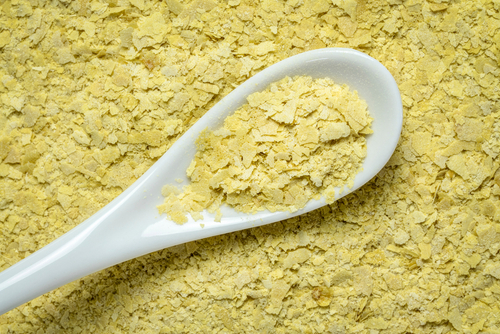

We’re all familiar with yeast as an ingredient used in brewing and baking, however, more and more people are using a form of yeast, known as nutritional yeast, as an ingredient in plant-based dishes. As well as providing a distinctly cheesy flavour to dishes, nutritional yeast is a valuable source of nutrients, especially for vegans and vegetarians.
Yeast is a fungus that has existed for hundreds of millions of years. Living or active yeast is responsible for the process of fermentation which is used in baking and brewing alcohol. Nutritional yeast is different in that the yeast cells are deactivated and then dried. Because the yeast cells are deactivated, there is no point in using nutritional yeast to make your bread rise. It should be used for adding flavour and boosting the nutrient content of your meals.
Nutritional yeast is a food ingredient derived from Saccharomyces Cerevisiae, a single-celled organism that is cultivated on molasses, picked, cleaned, and dried with heat to kill or “deactivate” it. It has no leavening ability since it is inactive and does not froth or develops like baking yeast.
The three primary forms of yeast that S. cerevisiae produces are:
Nutritional protein is high in protein, low in fat, and rich in vitamins and minerals.
Nutritional yeast contains a good variety of essential amino acids, however, because it is normally eaten in very small amounts, it is not normally an appreciable source of protein for vegans and vegetarians.
Nutritional yeast is a good source of most B vitamins, which are important for energy release in the body. The main exception is vitamin B12, which is naturally only found in foods of animal origin. Some nutritional yeast is fortified (artificially added) with vitamin B12. This is a particularly good option for vegans who may struggle to get enough vitamin B 12 in their diet.
The fibre found in nutritional yeast, beta-glucan, has been shown to reduce cholesterol levels. However, nutritional yeast is unlikely to be eaten in sufficient quantities to have a cholesterol-lowering effect.
Many vegans consume fortified nutritional yeast, which contains the daily required quantity of B12, which is often lacking in vegan diets. Selenium, potassium, folate, and iron are all found in fortified nutritional yeast.
Nutritional yeast is not to be confused with Brewer’s Yeast, which is a completely distinct type of yeast. Nutritional yeast is shelf-stable if kept in an airtight container in a cold, dry location. It may be used as a topping for popcorn or pasta, similar to how Parmesan cheese is used, or as a basis for cheesy sauces and dips.
Nutritional yeast comes in the form of powder and flakes. It is commonly used instead of parmesan in vegan dishes, says Anne-marie O’Shea, Technical Specialist in Nutrition at Future Fit Training. It doesn’t require any cooking or preparation; simply sprinkle it over pasta dishes, mashed potatoes or roasted vegetables. It can also be used in baking, for example, to make cheese-flavoured bread or scones.
Nutritional yeast can be used in moderation, up to several tablespoons (10–30 grammes) each day.
To surpass the acceptable upper intake limits (UL) for the vitamins and minerals it contains, nutritional yeast would have to be consumed in huge quantities.
Those who are allergic to yeast should avoid it, according to research.
Those who have a hard time metabolising folic acid, such as those with the MTHFR gene mutation, should read labels carefully and choose unfortified nutritional yeast.